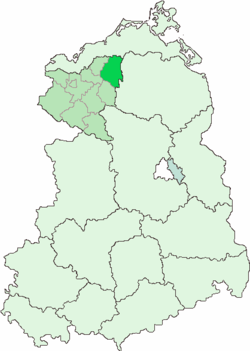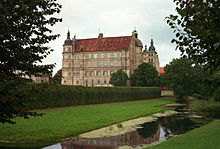District of Güstrow
The Güstrow district was a district in the northeast of the Schwerin district in the GDR . From May 17, 1990, it continued as the district of Güstrow . Today his area belongs to the Rostock district in Mecklenburg-Western Pomerania . The seat of the district administration was in Güstrow .
geography
location
The district area extended from the Recknitz glacial valley into the northern part of the Mecklenburg Lake District and had parts of the foothills of Mecklenburg Switzerland in the east - the Tannenberg (108 m above sea level ) also had the highest elevation here. The Krakower See in the south of the district (the seventh largest lake in the GDR) drains through the fog in the direction of Warnow to the Baltic Sea.
Area and population
The area of the district of Güstrow was 1002 km². That corresponded to 11.6% of the area of the Schwerin district.
The population of the district was 71,300 in 1985. That was 12% of the district's residents. The population density was 71 inhabitants per km².
Neighboring areas
The Güstrow district bordered the Bützow district in the north- west, the Sternberg district in the west, the Lübz district in the south-west and south, the Waren district in the southeast, the Teterow district in the east and the Rostock-Land district in the north .
history
The Mecklenburg county Güstrow was the remnants of the dismantled in the dissolution of the country on 25 July 1952 in three parts the district Güstrow . The district belonged to the newly formed Schwerin district. On October 3, 1990, he came to the newly founded state of Mecklenburg-Western Pomerania within the accession area to the Federal Republic of Germany . On June 12, 1994 the district (referred to as the district since May 17, 1990) was dissolved and reunited in the Güstrow district together with the Teterow and Bützow districts (except for the Schwaan district , which fell to the Bad Doberan district ).
Economy and Infrastructure
Agriculture played a major role in many villages in the district, and tourism around Lake Krakow. The largest industrial company in the district was VEB Landmaschinenbau Güstrow .
1984 military airfield was Laage from the Air Force / Air Defense of the NVA commissioned. The Jagdbombenfliegergeschwader 77 and the Marinefliegergeschwader 28 were stationed at this place .
With the Berlin-Rostock motorway , which crossed the Güstrow district in a north-south direction, and the long-distance roads 103 , 104 and 108 , the area of the district was well connected to the centers in the north of the GDR. The main railway line Berlin-Rostock and five railway lines from and to Güstrow completed the convenient location. All municipalities in the district were served by intercity buses from VEB Kraftverkehr Güstrow .
cities and communes
On October 3, 1990, the district of Güstrow had 41 municipalities, including three cities:
License Plate
Motor vehicles (with the exception of motorcycles) and trailers were assigned three-letter distinctive signs starting with the letter pairs BC and BD from around 1974 to the end of 1990 . The last number plate series used for motorcycles was BS 14–66 to BS 23–95 .
At the beginning of 1991 the district received the distinguishing mark GÜ .
Individual evidence
- ↑ a b Federal Statistical Office (ed.): Municipalities 1994 and their changes since 01.01.1948 in the new federal states . Metzler-Poeschel, Stuttgart 1995, ISBN 3-8246-0321-7 .
- ↑ Law on the self-administration of municipalities and districts in the GDR (municipal constitution) of May 17, 1990
- ↑ Andreas Herzfeld: The history of the German license plate . 4th edition. German Flag Society V., Berlin 2010, ISBN 978-3-935131-11-7 , pp. 301 .
- ↑ Andreas Herzfeld: The history of the German license plate . 4th edition. German Flag Society V., Berlin 2010, ISBN 978-3-935131-11-7 , pp. 550 .



